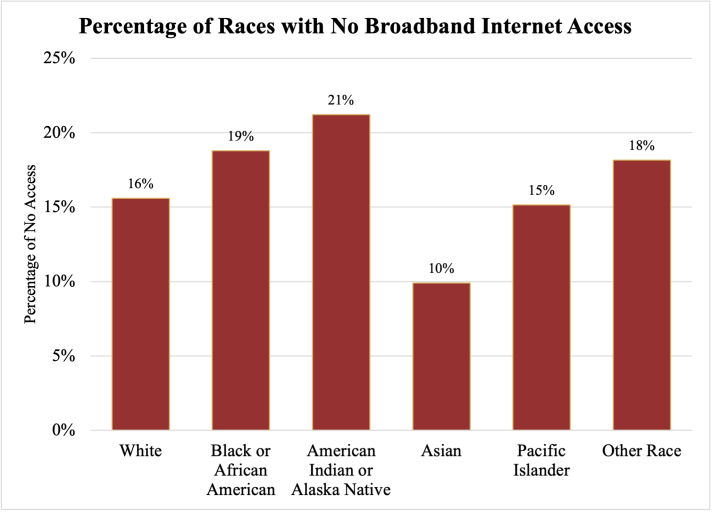By Andje Louis
The internet and related technologies–smartphones, computers, search engines, social media platforms–have become ingrained tools in everyday life. As more services and resources are made available online, digital inequality has come to mirror income and healthcare gaps among the world’s more marginalized populations, such as low-income and underrepresented groups.
While most people use the internet on a daily basis, access to it is still limited for a portion of the population. According to Prieger, minorities continue to face significant gaps in broadband usage–both fixed and mobile. The groups with the least access to the internet, based on 2020 data, are American Indians/Alaska Natives at 21 percent, Black or African Americans at 19 percent, and other races with 18 percent (Figure 1). From data collected by the Pew Research Center in a 2021 survey, about four out of ten low-income persons do not have access to home broadband or a desktop or laptop computer.

With the spread of COVID-19 forcing layoffs worldwide, many individuals are in the process of changing jobs. It is the ideal time to make use of online learning platforms. Massive Open Online Courses (MOOCs) are open online courses that anyone can access. MOOCs are a cost-effective and flexible method of learning valuable skills and enhancing a career, along with providing high-quality education opportunities to a large number of people. Coursera, Udemy, FutureLear, and EdX are among the many MOOCs available to those with internet access. YouTube is sometimes considered a similar platform due to the plethora of instructional videos available. Most of these platforms partner with universities such as Princeton, Stanford, and others around the world to deliver their topics, while others are from individual contractors.
These platforms offer free and paid courses which sometimes come with certifications that can be added to résumés or CVs. An email account can give access to a wide catalog of learning materials, with topics ranging from Python to portraiture. While employers favor traditional degrees (associate, bachelor, master), MOOC certificates are preferred over the lack of any credentials.
According to Samantha Audsley and co-authors (2013), these platforms are “changing the ways in which the world believes traditional education should function.” Thousands of students can learn from a single professor thanks to advanced computer technologies and complex web design.
However, many students may not know of these tools or they might lack the necessary device and/or internet connection to utilize them. Similarly to the broadband chart above, Black/African Americans (23%), American Indians/Alaska Natives (21%), and other races (19%) have the highest percentage of no device ownership.

Solutions exist to provide internet and access to devices. Both government and private entities could work to spread broadband internet across a wider range of the population. Telecommunication companies such as Comcast have internet essentials packages that offer internet services, discounted devices, free internet training, and WiFi or Xfinity hotspots. To be eligible, one must meet specific criteria. Examples of such criteria are if the individual qualifies for public assistance programs (Medicaid, Snap, SSI, etc.), resides in a location where Comcast internet service is offered, isn’t an existing Xfinity subscriber, and doesn’t have any outstanding debt against Comcast. Additionally, the Broadband Technology Opportunities Program (NTIA) is a project that focuses on the deployment of the broadband internet infrastructure, the enhancement and expansion of public computer centers, and the encouragement of long-term broadband adoption across the United States.
Regions without broadband connectivity can participate in community internet service agreements, which can be less expensive than the standard retail pricing and provide higher connection speeds. Another option to address the internet/device challenge would be for government agencies to collaborate with local libraries since most of them have computers available for members to use for a variety of tasks. Workshops can be implemented to introduce people to these learning tools previously mentioned. Libraries should collaborate with the aforementioned MOOC programs to make the completion and certification process easier for learners.
Broadband connectivity gaps can have ramifications for the economy of entire communities. Many industries require digital capabilities, which increases the demand for dependable technology. Smartphones are useful for small functions such as calls/texts, brief searches, notes, and so on; however, when it comes to substantial video material for learning purposes, they are inadequate. If provided access to devices and steady, high-speed internet, marginalized groups of people can make use of the different online resources available and perhaps better their socioeconomic positions in the long run.
References
Audsley, Samantha, Bronwen Maxson, Brittany Robinson, and Kalyani Fernando. 2013. “An Examination of Coursera as an Information Environment: Does Coursera Fulfill Its Mission to Provide Open Education to All?” The Serial Librarians, (August), 136-166. 10.1080/0361526X.2013.781979.
Shah, Dhawal. 2022. “Massive List of MOOC Platforms Around The World in 2022 — Class Central.” Class Central. https://www.classcentral.com/report/mooc-platforms/.
National Telecommunications and Information Administration. “Broadband Technology Opportunities Program.” n.d. Accessed March 3, 2022. https://www.ntia.doc.gov/category/broadband-technology-opportunities-program.
Prieger, James E. 2013. “The Broadband Digital Divide and the Benefits of Mobile Broadband for Minorities.” Journal of Economic Inequality, (April), 373-400. 10.2139/ssrn.2258081.
Rivas, Mariela J., Rachel B. Baker, and Brent J. Evans. “Do MOOCs Make You More Marketable? An Experimental Analysis of the Value of MOOCs Relative to Traditional Credentials and Experience.” AERA Open, (October 2020). https://doi.org/10.1177/2332858420973577.
Xfinity. “Apply for Internet Essentials from Comcast.” Accessed March 3, 2022. https://www.xfinity.com/support/articles/comcast-broadband-opportunity-program.

Meet the Author:
Andje Louis is a Political Science and International Affairs double major with a minor in Business Analytics. She has been a member of the DMC’s Data Analytics Group since January 2022. Andje’s research focuses on digital learning platform accessibility, particularly in the COVID-19 period. Her study focuses on low-income and minority populations, and the potential barriers that may limit their access. Outside of the DMC, Andje is involved with the University Libraries. She works as a data analyst for the Assessment Department and is now analyzing the findings of the LibQUAL survey. Andje’s interests include reading, exercising, and exploring new locations to visit.
